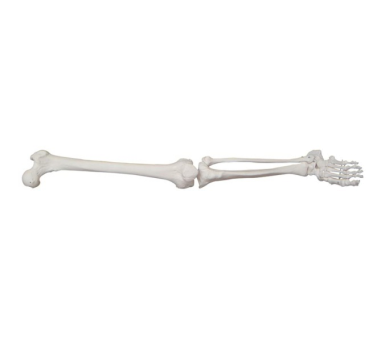Lower limb skeleton model plays a vital role in medical education, its intuitive and vivid characteristics enable students to learn and understand the structure and function of human lower limbs. The following is the specific application of the lower limb bone model in medical education:

Basic Anatomy teaching:
The lower limb bone model provides students with a clear display of the lower limb bone structure, from the femur and patella of the thigh, to the tibia and fibula of the lower leg, and then to the tarsals, metatarsals and phalanges of the foot.
By observing the model, students can understand the arrangement order, connection mode and spatial position relationship of lower limb bones, which lays a solid foundation for the subsequent anatomy study.
Bone function demonstration:
The lower limb bone model can not only show the static structure of the bone, but also cooperate with other teaching tools (such as joint model, muscle model, etc.) to demonstrate the motor function of the lower limb.
For example, by simulating the flexion and extension movement of the knee joint, students can intuitively understand the structure and movement mechanism of the knee joint, as well as the important role of the knee joint in movement.
AIDS for diagnosis and treatment of diseases:
When learning the diagnosis and treatment of orthopedic diseases, the lower limb bone model can be used as an auxiliary tool to help students understand the pathogenesis and treatment of diseases.
By simulating pathological changes such as fractures and dislocations on the model, students can gain a deeper understanding of the clinical manifestations and treatment of these diseases and prepare for future clinical practice.
Simulation equipment for clinical skills training:
Clinical skills training is an essential part of medical education. The lower limb bone model can be used as simulation equipment to train students' clinical operation skills.
For example, in the process of simulating the reduction and fixation of lower limb fractures, students can perform practical operations on the model to improve their clinical operation ability and the ability to respond to emergency situations.
Stimulate student interest and improve learning:
The lower limb skeleton model can stimulate students' interest and curiosity with its intuitive and vivid characteristics. By observing and manipulating the model, students can have a deeper understanding of the structural and functional characteristics of the human lower limbs, thereby improving the learning effect and memory depth.
To sum up, the lower limb bone model has a wide range of application value in medical education, which can not only help students better understand and master the structural and functional characteristics of human lower limbs, but also improve their clinical operation ability and emergency response ability.
